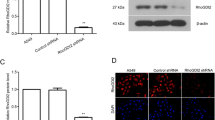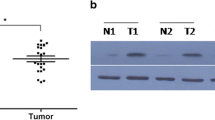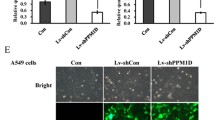Abstract
This study aimed to investigate the expression, function, and possible mechanism of Src in the Hep-2 cell line. We used Src-specific small interfering RNA (siRNA) to inhibit the expression of Src in Hep-2 cells. RT-PCR and Western blot were applied to evaluate the expression level of Src after RNA interference, and the MTT assay and flow cytometry were used to observe the expression of PI-3 K and Akt. siRNA can downregulate the expression of Src in Hep-2 cells. Downregulation of Src decreased PI-3 K and Akt expression. We found that Src knockdown inhibits the proliferation of Hep-2 cells and the growth of laryngeal carcinoma in vivo. This study has demonstrated that Src participates in the regulation of apoptosis through the Src/PI-3 K/Akt signaling pathway in the Hep-2 cell line. Silencing of Src by siRNA is a viable approach in laryngeal carcinoma treatment.







Similar content being viewed by others
References
Jemal A, Siegel R, Ward E, Hao Y, Xu J, Thun MJ. Cancer statistics. CA Cancer J Clin. 2009;59:225–49.
Nestle FO, Alijagic S, Gilliet M, et al. Vaccination of melanoma patients with peptide- or tumor lysate-pulsed dendritic cells. Nat Med. 1998;4:328–32.
Sanderson RJ, Ironside JA. Squamous cell carcinomas of the head and neck. BMJ. 2002;325:822–7.
Summy JM, Gallick GE. Src family kinases in tumor progression and metastasis. Cancer Metastasis Rev. 2003;22:337–58.
Trevino JG, Summy JM, Lesslie DP, et al. Inhibition of SRC expression and activity inhibits tumor progression and metastasis of human pancreatic adenocarcinoma cells in an orthotopic nude mouse model. Am J Pathol. 2006;168:962–72.
Johnson FM, Saigal B, Talpaz M, Donato NJ. Dasatinib (BMS-354825) tyrosine kinase inhibitor suppresses invasion and induces cell cycle arrest and apoptosis of head and neck squamous cell carcinoma and non-small cell lung cancer cells. Clin Cancer Res. 2005;11:6924–32.
Slack JK, Adams RB, Rovin JD, Bissonette EA, Stoker CE, Parsons JT. Alterations in the focal adhesion kinase/Src signal transduction pathway correlate with increased migratory capacity of prostate carcinoma cells. Oncogene. 2001;20:1152–63.
Elbashir SM, Harborth J, Lendeckel W, Yalcin A, Weber K, Tuschl T. Duplexes of 21-nucleotide RNAs mediate RNA interference in cultured mammalian cells. Nature. 2001;411:494–8.
Pecot CV, Calin GA, Coleman RL, Lopez-Berestein G, Sood AK. RNA interference in the clinic: challenges and future directions. Nat Rev Cancer. 2011;11:59–67.
Dayu Li, Marie A. Shatos, Robin R. Hodges, and Darlene A. Role of PKCa Activation of Src, PI-3K/AKT, and ERK in EGF stimulated proliferation of rat and human conjunctival goblet cells. Dartt IOVS,2013; 54(8): 5661-5673
Dong LB, Li GQ, Tian ZH, Wang ZM, Xu K. Expressions of Src homology 2 domain-containing phosphatase and its clinical significance in laryngeal carcinoma. Genet Mol Res. 2013;12(4):4207–12.
Franke TF. PI3K/Akt: getting it right matters. Oncogene. 2008;27:6473–88.
Chen JH, Yeh KT, Yang YM, Chang JG, Lee HE, Hung SY. High expressions of histone methylation- and phosphorylation-related proteins are associated with prognosis of oral squamous cell carcinoma in male population of Taiwan. Med Oncol. 2013;30:513.
Tang DG, Shin YJ, Kim J-H. The role of EZH2 in the regulation of the activity of matrix metalloproteinases in prostate cancer cells. PLoS ONE. 2012;7:e30393.
Hock H. A complex polycomb issue: the two faces of EZH2 in cancer. Genes Dev. 2012;26:751–5.
Nakagawa S et al. Enhancer of zeste homolog 2 (EZH2) promotes progression of cholangiocarcinoma cells by regulating cell cycle and apoptosis. Ann Surg Oncol. 2013;3:667–75.
Song Y, Sun X, Bai W-l, Ji W-y. Antitumor Effects of dasatinib on laryngeal squamous cell carcinoma in vivo and in vitro. Eur Arch Otorhinolaryngol Head Neck. 2013;270(4):1397–404.
Tanno S, Mitsuuchi Y, Altomare DA, Xiao GH, Testa JR. AKT activation up-regulates insulin-like growth factor I receptor expression and promotes invasiveness of human pancreatic cancer cells. Cancer Res. 2001;61(2):589–93.
Liau SS, Jazag A, Whang EE. HMGA1 is a determinant of cellular invasiveness and in vivo metastatic potential in pancreatic adenocarcinoma. Cancer Res. 2006;66(24):11613–22.
Feng F-L, Yong Y, Liu C, Zhang B-H, Cheng Q-B, Li B, et al. KAT5 silencing induces apoptosis of GBC-SD cells through p38MAPK-mediated upregulation of cleaved Casp9. Int J Clin Exp Pathol. 2014;7(1):80–91.
Ye P, Liu J, He F, Wen X, Yao K. Hypoxia-induced deregulation of miR-126 and its regulative effect on VEGF and MMP-9 expression. Int J Med Sci. 2014;11(1):17–23.
Funding
This study was supported by the Nature Science Foundation of China, NSFC (nos. 81241083).
Conflict of interest
None
Author information
Authors and Affiliations
Corresponding author
Rights and permissions
About this article
Cite this article
Song, Y., Dong, Yd., Bai, Wl. et al. Silencing of Src by siRNA inhibits laryngeal carcinoma growth through the Src/PI-3 K/Akt pathway in vitro and in vivo. Tumor Biol. 35, 9009–9014 (2014). https://doi.org/10.1007/s13277-014-2167-7
Received:
Accepted:
Published:
Issue Date:
DOI: https://doi.org/10.1007/s13277-014-2167-7




